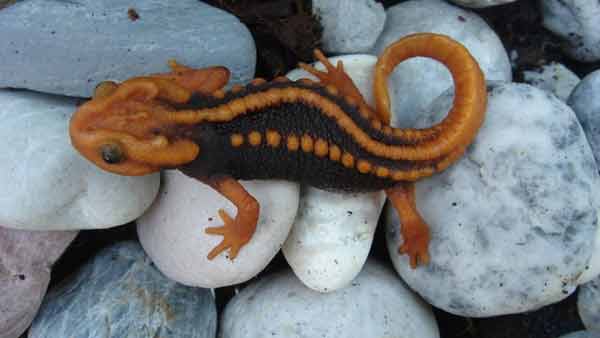
Gland, Switzerland (BBN) - “Tylototriton anguliceps” is his name, but Klingon Newt is much easier to pronounce.
Someone decided he looks like a Klingon from “Star Trek”, so that’s what the World Wildlife Fund is calling him, reports foxnews.com.
He’s a newt found in Thailand that, if he’s lucky, can grow to just over 2½ inches long.
And while that may sound small, it is downright Brobdingnagian when compared to “Leptolalax isos”, aka the Orange-Eyed Litter Frog of Cambodia and Vietnam, which is smaller than 1¼ inches long.
What the newt and the frog have in common is that they are two of the 163 new species discovered in 2015 in the Greater Mekong Region of Southeast Asia.
Among the others, as reported by the World Wildlife Fund, are:
* A rainbow-headed snake discovered in Laos that resembles David Bowie’s Ziggy Stardust;
* A rare banana species found in Thailand;
* A gecko with pale blue spotted skin and piercing dark eyes that was discovered in Laos;
* A purple mouse-eared flower found in Burma;
* A wooly-headed bat found in Vietnam.
The Mekong River, which runs from China’s Tibetan-Qinghai Plateau to the South China Sea off Southern Vietnam, has become a Xanadu for scientists, who discovered 2,409 new species in the region between 1997 and 2015 and are currently finding them at the rate of two per week.
“The Greater Mekong region is a magnet for the world’s conservation scientists because of the incredible diversity of species that continue to be discovered here,” says Jimmy Borah, wildlife program manager for WWF-Greater Mekong, in a statement.
“These scientists, the unsung heroes of the planet, know they are racing against time to ensure that these newly discovered species are protected and saved.”
The 163 species discovered in 2015 included nine amphibians, 11 fish, 14 reptiles, 126 plants and three mammals.
None of them were previously known to exist, and, due to habitat destruction and the possibility of being captured by poachers or illegal wildlife traders, it’s unknown whether they can continue to exist.
“Many collectors are willing to pay thousands of dollars or more for the rarest, most unique and most endangered species, often buying them at the region’s illegal wildlife markets, especially in the Golden Triangle region where China, Laos, Thailand and Myanmar meet,” Borah said.
“To save them, it’s crucial that we improve enforcement against poaching and close illegal wildlife markets as well as the tiger and bear farms that openly flaunt wildlife laws.”
Alexandre Teynié, one of a team that found the “Ziggy Stardust” snake, aka Parafimbrios lao, said the discoveries represent “a small stepping stone to the living heritage of humanity.
A small but bright spot for understanding the history of populations, the evolution of life, and a sense of humility before our ignorance.
“If we are able to protect these vital landscapes and the biodiversity they hold, then we can ensure that generations to come will be able to make their own new discoveries and add to our collective understanding of the world around us.”
BBN/MS/ANS